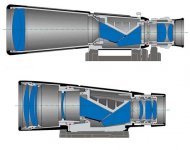spitfiretriple
Well-known member
Zeiss has used, and continues to use, Abbe-Koenig prisms, while almost all of the rest of the roof world uses Schmidt-Pechan. AK prisms are lighter, and give a brighter image, but are longer, making for a longer bin. The longer tubes however, would be perfectly suited to an open bridge design. Why doesn't Zeiss follow Swarovski and move to open bridge? Or have I effectively just answered my own question?





